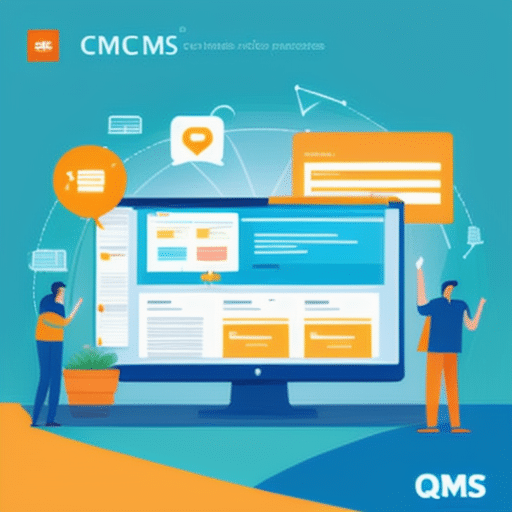CMS, also known as content management systems, are fundamental tools for the creation and maintenance of websites.
Today, there are numerous options available on the market, each with its own characteristics and advantages.
Therefore, it is essential to know in depth what a CMS is, what are its main benefits and how to choose the most suitable one for each project..
In this article, we will delve into the world of CMS, exploring the different types that exist, as well as the best practices for their installation, configuration and optimal use on your website.
Introduction to CMS: definition and characteristics
A CMS (Content Management System) is a software that allows the creation, management and publication of online content.
In other words, it is a tool that facilitates the administration of a web site without the need for advanced programming knowledge.
CMSs offer an intuitive graphical interface that allows users to create and edit content quickly and easily.
Among the most outstanding features of CMSs are the possibility of customizing the website design through predefined or personalized templates, user management with different permission levels, integration with different tools and applications, search engine optimization (SEO) and the ability to adapt to different mobile devices.
In addition, CMSs allow the creation of multiple pages and sections, which facilitates the organization of content and its constant updating.
In short, CMSs are an effective solution for those looking to create and manage a website without advanced technical knowledge.
With the right CMS, anyone can create a professional website quickly and easily.
The benefits of using a CMS on your website
The benefits of using a CMS on your website are numerous and very important.
First of all, a CMS allows you to create and update content quickly and easily, which is especially useful if you have a website with a lot of content or if you need to update it frequently.
In addition, a CMS allows you to manage different users and permissions, which means that you can give access to different people to edit content without having to worry about the security of your website.
Another advantage is that CMSs are often very flexible and customizable, allowing you to tailor the design and functionality of your website to your specific needs.
In addition, many CMSs offer a wide variety of plugins and extensions that allow you to easily add new features to your website.
Finally, CMSs are often very efficient in terms of SEO, as they are designed to facilitate the optimization of content for search engines.
In summary, using a CMS can help you save time and effort in managing your website, improve its security and customization, and increase its visibility in search engines.
Types of CMS: which one is right for you?
There are different types of CMS on the market, each with its own specific features and functionalities.
Before choosing a CMS for your web project, it is important to evaluate your needs and objectives to determine which one is right for you.
One of the most popular types of CMS are the open source ones, such as WordPress or Joomla.
These systems are free and offer a wide variety of plugins and themes to customize your website.
In addition, they have a large community of developers who are constantly working to improve their functionality and security.
On the other hand, there are also proprietary CMSs, such as Adobe Experience Manager or Sitecore, which are usually used by large companies due to their high customization capacity and scalability.
These systems tend to be more expensive than open source systems and require specialized personnel for implementation and maintenance.
Another type of CMS are the SaaS (Software as a Service), such as Wix or Shopify, which offer comprehensive solutions for the creation and management of websites without the need for technical knowledge.
These systems are usually very easy to use and have 24/7 technical support.
In conclusion, choosing the right type of CMS for your web project will depend mainly on your specific needs, budget and level of technical knowledge.
It is important to research and compare the different options available in the market before making a decision.
Main CMS on the market: advantages and disadvantages
The main CMSs on the market include WordPress, Joomla, Drupal, Magento and Shopify.
Each of them has advantages and disadvantages that should be considered before choosing the most suitable one for a specific web project..
WordPress is the most popular CMS due to its ease of use and the large number of templates and plugins available..
However, their safety can be a problem if appropriate measures are not taken.
Joomla, on the other hand, is more complex than WordPress but offers greater flexibility in terms of website customization.
Although it has a smaller community than WordPress, it has good documentation and support.
Drupal is a very powerful CMS used mainly for large and complex web projects.
It offers a lot of customization and control options, but its learning curve is steeper than other CMSs..
Magento is an e-commerce focused platform that offers a wide range of specific features for online stores..
It is scalable and robust, but also requires advanced technical knowledge.
Finally, Shopify is a specialized e-commerce CMS that offers an easy and hassle-free experience for users looking to create an online store..
However, customization is limited to preset templates and can be costly for large stores.
In conclusion, each CMS has its own advantages and disadvantages depending on the specific project in question..
It is important to carefully evaluate these features before making a final decision on which CMS to use.
How to choose the perfect CMS for your web project
Choosing the perfect CMS for a web project can be a challenging task, but it is crucial to ensure its success.
The first thing to consider is the purpose of the website and the functionalities required.
If an e-commerce website is needed, it is important to choose a CMS that has online sales capabilities, such as WooCommerce or Magento.
If the goal is to create a blog, WordPress is an excellent choice due to its ease of use and wide variety of available templates and plugins.
Another important factor to consider is the community behind of the CMS.
A CMS with a large active community means that there is a wealth of resources and support available online..
It is also important to consider CMS security, as websites can be vulnerable to cyber attacks if adequate preventive measures are not taken.
Scalability is also an important factor.
It is important to choose a CMS that can grow with the website and adapt to future needs.
For example, if the website starts as a personal blog, but is expected to grow as the audience increases, it is important to choose a CMS that can handle the additional traffic smoothly.
Finally, the budget must also be considered.
Some CMSs are free, while others have costs associated with them.
It is important to assess how much you are willing to spend and whether the benefits of CMS justify the costs.
In summary, choosing the perfect CMS for a web project requires careful consideration of the purpose of the website, the community behind the CMS, security, scalability and available budget.
Taking the time to research and evaluate each option will ensure that the best decision is made for the web project.
Installation and configuration of a CMS step by step
Installing and configuring a CMS can be a complex task for those unfamiliar with the process.
However, with the right steps, it can be easily accomplished.
First, it is necessary to choose the CMS that best suits the needs of the website.
Once selected, download the installation package and unzip it on the web server.
Then, a database for the CMS must be created and assigned a username and password.
It is important to remember that some CMSs require additional configuration before installation, such as adjustments to the .
htaccess or the creation of an FTP account.
After completing these steps, the CMS installation file should be accessed through the web browser and the following instructions should be followed instructions provided.
During this process, you will be asked to provide basic information such as website name and administrator credentials.
Once the installation is complete, you can access the CMS administration panel and start customizing the website according to your specific needs.
Although there may be differences in the installation and configuration process depending on the CMS selected, these general steps can serve as a useful guide for anyone wishing to install a CMS on their website
Tips for optimizing the use of a CMS on your website
To optimize the use of a CMS on your website, it is important to follow some key tips.
First of all, it is essential to keep the CMS software and its plugins or add-ons up to date to avoid security vulnerabilities.
In addition, you should avoid installing too many unnecessary plugins that may negatively affect the loading speed of the site.
Another important aspect is to use responsive design templates or themes optimized for mobile devices, since more and more users access the Internet from their smartphones or tablets.
It is also advisable to limit the number of users with access to the CMS administration panel to avoid possible errors or bad practices.
On the other hand, it is necessary to create a clear and hierarchical content structure to facilitate navigation and improve the user experience.
It is also important to optimize images and multimedia files to reduce their size and improve site loading speed.
Finally, regular backups of the website are recommended to avoid possible loss of information in the event of technical failures or cyber-attacks.
By following these tips, you can get the most out of your CMS and ensure optimal and secure operation of your website.
In summary, CMSs are valuable tools for those looking to create and manage websites efficiently and effectively.
From the definition and features of a CMS to the step-by-step installation and configuration, this article has provided useful information on how to choose and use the right CMS for your web project..
Although the main CMSs on the market have specific advantages and disadvantages, it is important to take into account the individual needs of your website when choosing one.
In addition, optimizing the use of a CMS can be a continuous process that takes time and constant attention.
How do you think CMSs might evolve in the future, and will they be able to adapt to changing technology and security needs? Reflecting on these questions can help us be prepared for what is to come in the CMS world.




